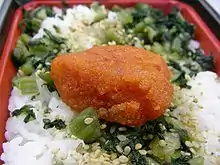| Nozawana | |
|---|---|
 | |
| Nozawana | |
| Scientific classification | |
| Kingdom: | |
| (unranked): | |
| (unranked): | |
| (unranked): | |
| Order: | |
| Family: | |
| Genus: | |
| Species: | B. rapa (syn B. campestris) |
| Variety: | B. r. var. hakabura |
| Trinomial name | |
| Brassica rapa L. var. hakabura | |

Mentaiko and nozawana on rice
Nozawana (野沢菜, Brassica rapa L. var. hakabura) is a Japanese leaf vegetable, often pickled.[1] It is of the same species as the common turnip and one of a Japanese variety of mustard leaf.[2] Its leaves are approximately 60–90 cm long.
Traditionally it is thought that sometime between 1751 and 1764 the plant was brought from the Kyoto mountains to the Nozawa-onsen village by the master of a Buddhist temple who lived in Nozawa. It was since cultivated around that area, and thus named Nozawana: na means vegetable in Japanese.
Pickled nozawana is one of the most typical local foods in Nagano Prefecture. It is also used in onigiri.[3]
References
- ↑ "Nozawana - the perfect pickle in Nozawa Onsen". Nozawa Holidays. 2016-08-16. Retrieved 2019-06-25.
- ↑ "Pickled Mustard Leaves (Nozawana-zuke)". Asian Inspirations. 2017-07-17. Retrieved 2019-06-25.
- ↑ "Japanese Savoury Buns (Nozawana Oyaki)". Asian Inspirations. 2017-07-17. Retrieved 2019-06-25.
This article is issued from Wikipedia. The text is licensed under Creative Commons - Attribution - Sharealike. Additional terms may apply for the media files.